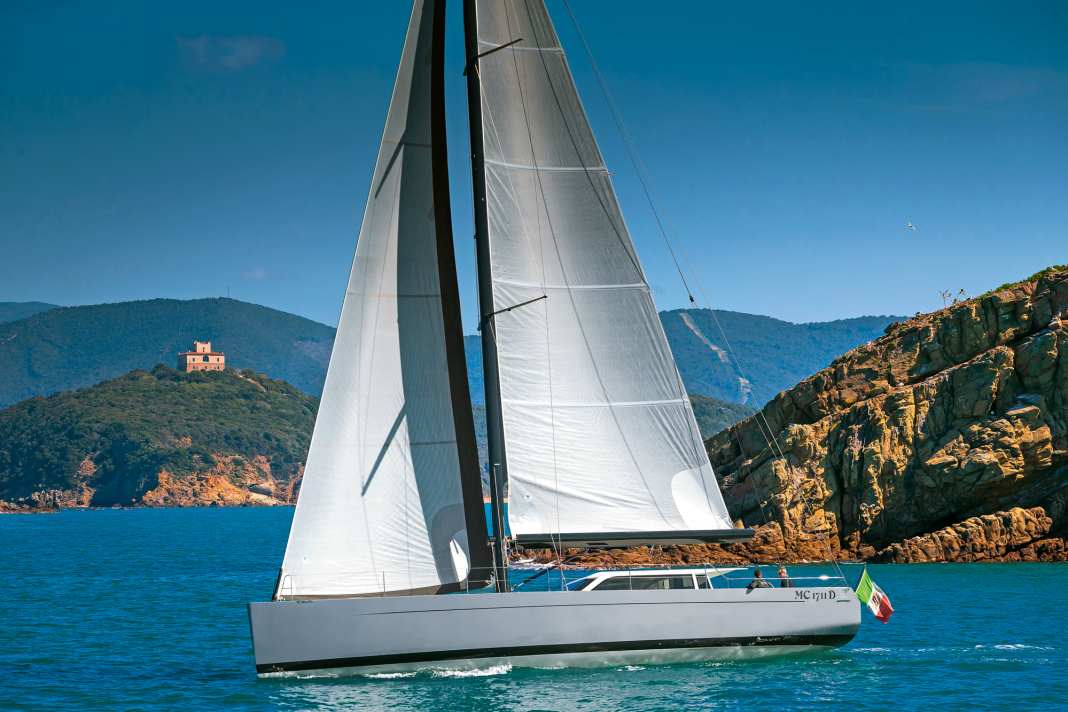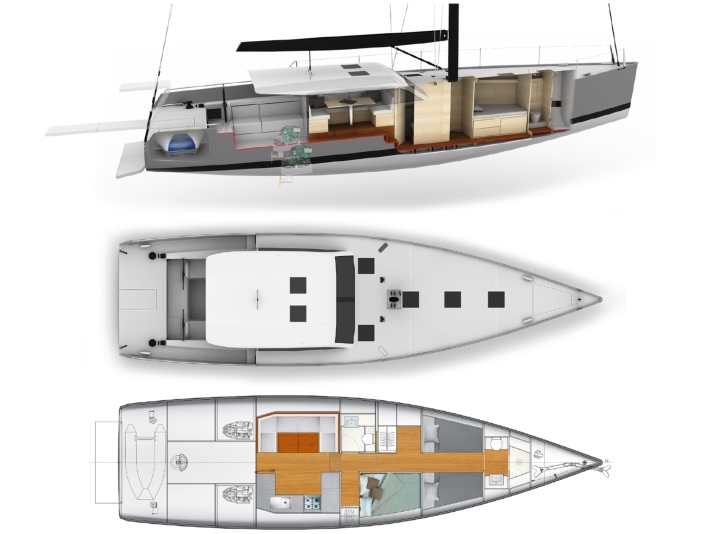





- Despite series production: the owner remains king at Vismara - he decides
- Bruni only wants to cruise with his "Dragon", not race
- Living and sailing on one level like a catamaran
- The deck of the Vismara V50 remains sheer, all lines are led below deck
- Technical data of the Vismara V 50 "Dragon"
- Hull and deck construction
The symbol of the dragon has fascinated him since he was a boy, says Angelo Bruni, rolling up his sleeve to show off the tattoo on his forearm: a fire-breathing dragon in large format. A similar emblem is also painted on the tank of his Harley-Davidson, which the Italian sometimes rides on the pier in the harbour of Punta Ala right in front of his ship. And there, too, "Dragon" is emblazoned in large letters on the rear.
All of his sailing boats to date have borne this name, explains the small, wiry man. And there have been quite a few - including four yachts from Vismara Marine. Calling something unique and exclusive his own has always been important to him in life, as he admits today.
Also interesting:
Angelo Bruni is a pensioner. He used to be a fashion designer in Florence and helped to establish a well-known jeans label, among other things. Not without success, it seems, otherwise Bruni would hardly be going in and out of the Vismara Marine jewellery factory today. There is no need to hide the fact that the shipyard in Viareggio is mainly frequented by a well-heeled clientele. Vismara's customers want something special and are prepared to fork out a corresponding budget for it.
The shipyard was founded in 1984 by Alessandro Vismara. The naval architect quickly made a name for himself with a series of successful quarter and three-quarter tonners. At the same time, Vismara became a dealer and service partner for the Finns of Baltic Yachts in the Mediterranean region. In the years that followed, not only did the shipyard's order volume increase, but so did the size of the yachts built there. At the end of the 20th century, Alessandro Vismara crowned his portfolio with the realisation of the 120-foot schooner "Antonisa". By 2016, the shipyard had built almost 100 ships. They all have one thing in common: they were built as one-offs at the customer's request and are therefore purely customised projects.
Despite series production: the owner remains king at Vismara - he decides
As for many shipyards - not only in Italy - the years of crisis were also difficult for Vismara Marine. That is why a strategic adjustment was essential, says Product Manager Michele Antonini. Under the name "Prêt-à-porter", the Italians are now also launching a small programme of serially built yachts for the first time.
"Prêt-à-porter" at Vismara means nothing more than "semi-custom" in nautical parlance. This means that the customer decides on a basic model, but then has more or less free rein when it comes to the design (colours, shapes, woods, fabrics) and adapts the boat to their personal requirements, both inside and out, as far as possible. They can define the layout on deck themselves or determine the sail plan.
The owner also has the final say regarding the equipment on deck and chooses the layout below deck. This form of self-determination is supported by the Italian company with suitable equipment packages. Ultimately, the shipyard also wants to take the burden off the buyer and offer them help in the decision-making process.
On to the "Dragon", the prototype of the V50 series, and owner Angelo Bruni, the prototype of the typical "prêt-à-porter" customer. Looking back, he can't say exactly how many times he was at the shipyard during the construction period. "Very, very often," is all he says. He came to Vismara with very clear ideas: He wanted his boat to be as easy and uncomplicated to sail as possible, and unconditionally suitable for single-handed sailing. Bruni likes travelling alone, but he doesn't want to do without a certain size. And he doesn't want to have to work hard on board. In his eyes, sailing is recreation, not sport.
Bruni only wants to cruise with his "Dragon", not race
That is why the sail plan of the "Dragon" is kept very simple. Short genoa on a furling system, plus a conventional, triangular mainsail without luffing, which can be conveniently furled into the main boom. The mast is made of aluminium and is not particularly high. Although the boat is relatively light with a ready-to-sail weight of 13.3 tonnes, the sail carrying capacity of 4.7 remains in the relatively moderate range; Bruni only wants to cruise with his "Dragon", not race. For owners who pay more attention to sportiness and performance, the V50 could of course also be upgraded, for example with a higher carbon fibre mast.
An extremely appealing idea, because even in its relatively weak-chested version, the boat shows considerable potential in the wind. In only very light winds of around 6 knots, the Vismara V50 is already travelling at 5.5 knots at an angle of 40 degrees to the wind - that's almost as fast as it blows.
On the way back, however, it soon gets boring on the "Dragon", at least in light winds as in the test - the boat lacks the additional horsepower of a gennaker or a Code Zero. Owner Bruni then usually starts the engines. That's right: the engines! The V50 has two diesel engines installed on the side under the cockpit thwarts, each from Volvo Penta with 40 hp.
Apart from the fact that two engines drive up the purchase price, they offer a number of advantages. For example, the owner can turn his boat on the plate in the harbour without a bow or stern thruster, just like a catamaran with two engines. This makes mooring manoeuvres child's play for the solo sailor. When travelling long distances under engine power, two drives also ensure greater stability or are used alternately, just like on a catamaran. The ship should roll less in the waves and have better directional stability. Last but not least, at a speed of around 8 knots, two engines together consume less fuel than one larger and more powerful engine for the same performance. At least that's what Vismara's engineers claim.
It was not possible to measure this in the test, but it was possible to test it at full throttle. The maximum speed over ground was 10.5 knots - that's impressive.
Living and sailing on one level like a catamaran
The concept of the V50 is not really comparable with that of a conventional yacht of the same size. The side view shows a clear division into two sections along the length, not the height as is usually the case. The separating element here is the cabin bulkhead. People live in front of it, and only work and sail behind it. Beneteau realised a very similar concept with its unusual Sense line, as did Moody Boats with its DS programme. The idea is a strict spatial separation between the interior at the front and the technology aft. In the V50 from Vismara, all noise- and heat-producing technical installations are installed aft, for example the engines, the generator, the heating, the hot water boiler and, of course, the electric drives for the winches on deck. The separation ensures pleasant peace and quiet in the cabins, even under engine.
Due to the lack of living space in the rear of the boat, the cockpit can be as low as possible. Here you sit well protected, but still outside. The cockpit and saloon are on one continuous level, just like on a modern catamaran. There is no companionway in the classic sense, but rather a large door that connects the two areas inside and outside when open. The large, fixed bimini roof, which spans the cockpit and protects not only from rain and wind, but also from the particularly strong sunlight in the Mediterranean, is even more reminiscent of a catamaran.
The deck of the Vismara V50 remains sheer, all lines are led below deck
On deck, it is noticeable that there are no lines lying around anywhere except directly on the two large winches on the aft deck. All halyards, sheets and trim lines are hidden back there, tucked away somewhere in channels. Even the genoa sheets on the foredeck disappear immediately into the deck. There are no adjustable haul-out points, only fixed deflection blocks.
Owner Bruni has opted for an interior in plain white. The furniture is coated and the surfaces are glossy. Only a few cushions and the bed covers of the berths provide a change of colour. The atmosphere in the saloon below deck has the cool charm of a doctor's surgery. Only purists will be really happy with it. For those who like it cosier, however, Vismara can use more visible wood and play with the colours.
The layout of the interior is exciting. Similar to Beneteau's Sense concept, an open, central corridor leads to the foredeck. To the left and right of this are the centre cabins or the wet room, which can be configured as two or three cabins depending on the layout. There is additional variety in the foredeck, where you can choose between two separate berths or a large island bed. If you are interested in a V50, you can also put together your own dream boat using the online configurator on the Internet.
Up to now, all of Vismara's individual boats have been built using positive moulds. With the prêt-à-porter programme that has now been developed and a possible series production, the shipyard has now built a boat in a negative mould for the first time ever with the V50, using the vacuum infusion process with E-Glass and vinyl ester resins. Carbon fibre reinforcements are laminated into the hull in high-stress areas such as the keel area or the shrouds.
The V50 presents itself as an exciting, attractive mix of upmarket daysailer and Mediterranean gran turismo with many functional borrowings from the catamaran concept. This could be of interest to many.
Technical data of the Vismara V 50 "Dragon"

- Design: Vismara
- Torso length: 15,50 m
- Waterline length: 13,60 m
- Width: 4,30 m
- Depth: 2,50 m
- Weight: 13,3 t
- Sail area on the wind: 130,0 m2
Hull and deck construction
GRP sandwich construction (E-glass/foam core). Built using the vacuum infusion process
The article first appeared in YACHT 16/2016 and has been updated for the online version.

